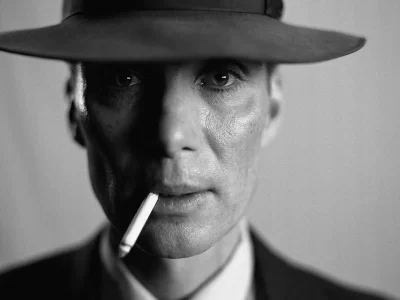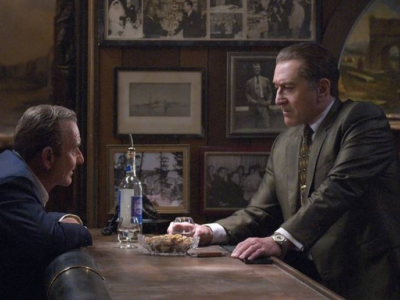Review| Downsizing
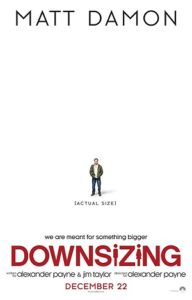 Reactions to Downsizing from critics and audiences have been mixed with scores ranging from 25 to 100. Be that as it may, most agree Downsizing has a fascinating premise that presents an interesting, albeit far fetched, solution to some of the world’s enduring problems. Tackling big ideas and themes, the film never does quite settle into a genre. It’s part comedy, social satire, and tragedy with apocalyptic and comedic moments. Much like the films’ main character, Paul Safranek (Matt Damon), the story grapples to find a main purpose, but while the whimsical storytelling can be disorienting at times, I’ll lay my cards on the table and say that I really enjoyed it and the discussion it inspired.
Reactions to Downsizing from critics and audiences have been mixed with scores ranging from 25 to 100. Be that as it may, most agree Downsizing has a fascinating premise that presents an interesting, albeit far fetched, solution to some of the world’s enduring problems. Tackling big ideas and themes, the film never does quite settle into a genre. It’s part comedy, social satire, and tragedy with apocalyptic and comedic moments. Much like the films’ main character, Paul Safranek (Matt Damon), the story grapples to find a main purpose, but while the whimsical storytelling can be disorienting at times, I’ll lay my cards on the table and say that I really enjoyed it and the discussion it inspired.
The film takes place in a not-so-distant future when Norwegian scientists have made a groundbreaking scientific discovery called “cellular reduction” or downsizing. The hope behind the new technology is to minimize humans’ carbon footprint and save the environment. In this new world we follow Paul Safranek. A mild mannered occupational therapist from Omaha who over the course of the first few scenes of the film, goes from living with and taking care of his ailing mother to living in the exact same house with his wife, Audrey (Kristen Wiig).
Paul and Audrey are in a rut. They are facing financial struggles and are genuinely interested in the concept of downsizing, especially when they reunite with some friends from high school who have taken the leap and now enjoy a comfortable existence in Leisureland, a community for small people. It turns out that sizeable tax breaks from the government and a generous exchange rates bolsters the appeal of “getting small” for people who are looking for a fresh start. Paul and Audrey believe they can do that in Leisureland where their $300,000 in equity becomes $12 million.
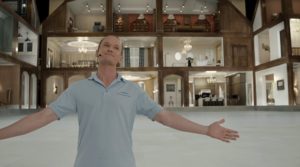 The film reminds us that if something sounds too good to be true, it probably is. Besides the larger problems that start to loom such as small people living in a big world, how small people’s rights should translate to society at large, and more, we flash forward one year to Paul’s life after downsizing as we observe his lonely routine as a bachelor. His occupational therapist license has expired leaving him with a monotonous telesales job.
The film reminds us that if something sounds too good to be true, it probably is. Besides the larger problems that start to loom such as small people living in a big world, how small people’s rights should translate to society at large, and more, we flash forward one year to Paul’s life after downsizing as we observe his lonely routine as a bachelor. His occupational therapist license has expired leaving him with a monotonous telesales job.
Things start to take a turn in the narrative when Paul attends a neighbors’ party where he breaks out of his shell and starts to let loose only to wake up the next morning in a stupor where he engages in a conversation with his playboy neighbor, Dusan (Christoph Waltz), who he learns is taking advantage of the system by providing Leisureland with the luxuries its residents crave.
I thought the film hit a bit of a slump as Paul’s character stumbles his way through his new life in Leisureland, but then things start to pick up again when we are introduced to Dusan’s counterpart, Ngoc Lan Tran (Hong Chau). Ngoc is a Vietnamese immigrant who tries to help people instead of use them. Ngoc shows Paul the darker side of Leisureland and encourages him to step outside of his narcissistic world. Chau pretty much carries the rest of the film making her recent Golden Globe nomination for best supporting actress no surprise.
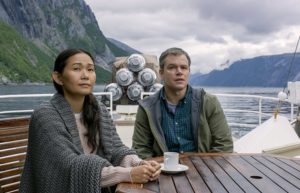 Ngoc invites Paul to see the pain and suffering on the outskirts of Leisureland and at the same time reminds us as an audience that no matter what solutions we try to find to the world’s biggest problems, people never change. Human beings are always looking for heaven on earth, and they will destroy the world and the people around them on the way to finding it.
Ngoc invites Paul to see the pain and suffering on the outskirts of Leisureland and at the same time reminds us as an audience that no matter what solutions we try to find to the world’s biggest problems, people never change. Human beings are always looking for heaven on earth, and they will destroy the world and the people around them on the way to finding it.
Despite this bleak reality, as the film swerves into its haphazard conclusion, we aren’t left feeling hopeless. As Ngoc and Paul’s relationship develops they rally around a shared purpose. The film strikes a balance between showing systemic problems on a large scale, but also zooming in to show us how each person’s story and contribution to that system is important, for good and bad.
While the ending doesn’t pull off this balance perfectly, the themes are interesting and relevant and I think it’s definitely worth the two hour and fifteen minute run time even if it’s just to enjoy the beautiful production design from Stefanie Cella and brief moments of humor.



